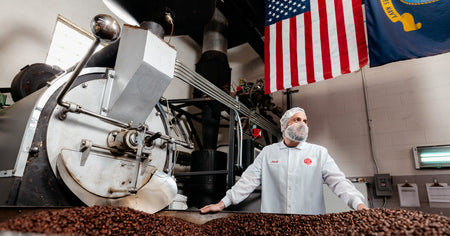November 18, 2020
Don’t worry: no mumbo jumbo ahead! Understanding coffee-to-water ratios can simply spare you from starting the day with a bitter cup of joe or a weak-as-water carafe.
That’s why we’re going to explain it to you in an easy, no-frills way.
From one coffee lover to another.
Why coffee-to-water ratio is so important

Because coffee is. Why would you want to spoil it? By understanding coffee-to-water ratio you can avoid over-extraction, which results in a bitter pot that might be too strong for your palate, and under-extraction, a heartbreaking watery mess that’s too weak to be classified as coffee.
How do you calculate coffee ratios?
To calculate coffee ratios, you simply need to multiply the second number (which refers to the amount of water) for the grams of coffee that you’re planning on using.
For example, for a 1:15 coffee-to-water ratio, you need to add 15 g of water for every gram of coffee. If you use 10 g of coffee grounds, that’s 150 g of water.
Easy, right?
What is the best coffee to water ratio?
Overall, the best coffee to water ratio is 1:15. If you haven’t got a scale at hand, that’s six ounces of water for every one or two tablespoons of coffee grounds.
A 1:15 ratio is a fantastic starting point but, if it tastes too strong for you, you can then tweak it to 1:16, 1:17 and so on. Too weak? Opt for 1:14 or 1:13.
However, while 1:15 is the best coffee-to-water ratio for most coffee makers, the optimal quantities change dramatically for a couple of peculiar methods.

Best drip coffee-to-water ratio
If you’re using an automatic dripper, the best coffee-to-water ratio is still 1:15. Or you can add two tablespoons of grounds per cup of water like we do.
Best French press coffee-to-water ratio
1:15 seems to be the best coffee-to-water ratio for French press too, but that’s if you’re grinding the beans yourself and can rely on consistent coarse grounds.
If you’re using pre-ground coffee, it’s usually a medium/medium-fine size. To balance this difference and avoid over-extraction, try 1:17 instead.
Best pour over coffee-to-water ratio
In general, the best coffee-to-water ratio for most pour over coffee makers is still 1:15. However, if you’re only just getting started with manual methods and are used to automatic drippers or French presses, be prepared because they’ll unlock more flavor nuances. If this pour over coffee tastes too strong for you, start with 1:16 or 1:17.
Best cold brew coffee-to-water ratio
The best coffee-to-water ratio for cold brew is 1:5. Here’s where things start to change quite drastically! To balance its much longer brew time, cold brew coffee needs less water per gram and is therefore a lot more concentrated than traditional java.
Best coffee-to-water ratio for espresso
Because it’s a highly concentrated shot, the best coffee-to-water ratio for espresso is 1:2. This is because espresso machines rely on a very short extraction time, usually around 20 seconds. Using fine grounds and a 1:2 ratio guarantees the strong shots that we need for an extra energy kick every once in a while.
If you’re making espresso-style coffee with a moka pot, a 1:6 or 1:7 ratio is the way to go. However, you don’t really need to measure it: just fill up the filter plate with grounds and pour water into the bottom chamber until you reach the valve, without covering it (unless you want a coffee with a bang… literally).
Now that you understand coffee-to-water ratio, you can really make the most of your favorite Fire Dept. Coffee beans or grounds!
Leave a comment
Comments will be approved before showing up.
Also in Fire Department Coffee News

Standing with Laurel County After an EF4 Tornado

FDC Featured In Nationwide Walmart Commercial and Celebrates Community Roots in Rockford

Rescue-1 Deploys to Texas: Fire Department Coffee Supports Communities After Catastrophic Flooding

Celebrating America’s Firefighting Presidents

Fire Department Coffee and Kidde Working Together to Promote Fire Safety

From Barista to Coffee Expert: Fire Dept. Coffee's Jacob Ball Brews Success

Get to Know the Hilarious, Hardworking Team Behind FDC Videos

From Fan to Family: How Lance Woodruff Became an FDC Star

Marine, Musician, Firefighter: Josh Kennedy is Doing It All

FDC Mobilizes Rosenbauer Fire Truck for Tennessee Tornado Relief

Fire Dept. Coffee's First Retail Shop Opens in Rockford, IL

Sugar Cookie Rum Infused Coffee - Spirit Infused Coffee Club
FOLLOW OUR JOURNEY, GET SPECIAL OFFERS AND PROMOTIONS
- SPIRIT INFUSED COFFEE
- Bourbon Infused Coffee
- Whiskey Infused Coffee
- Rum Infused Coffee
- Spirit Infused Coffee Club
- Spirit Infusion Process
GEAR
© 2025 Fire Department Coffee, Inc.











